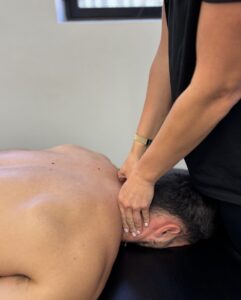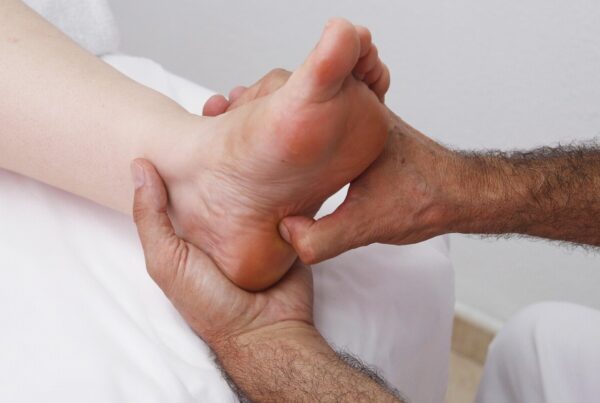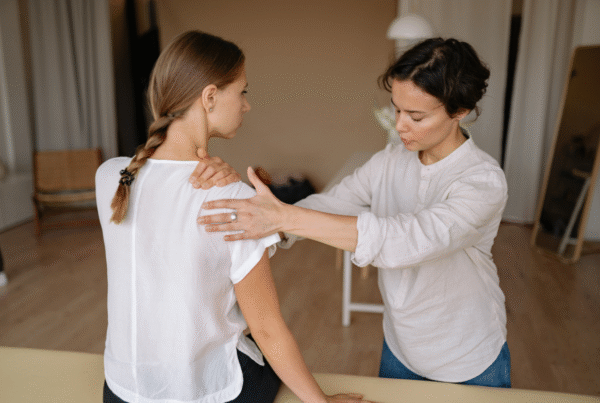Neck pain is one of the most common musculoskeletal complaints seen in physiotherapy practice. It can arise from a range of structures, including muscles, joints, nerves, and ligaments and is often influenced by posture, stress and lifestyle factors. Understanding the underlying cause is essential for guiding effective treatment and recovery.
Neck pain affects a significant number of Australians, although determining the exact prevalence can be challenging. Estimates differ depending on the definition used — whether pain is measured at a specific moment, across a 12-month period, or over a lifetime — and the type of population being studied. The RACGP reports that musculoskeletal neck pain may affect around 20% of adults in certain studies, while the Australian Physiotherapy Association notes that up to 70% of Australians will experience neck pain at some point in their lives. What is clear is that neck pain is highly common, especially among individuals in office-based or computer-intensive roles, a common demographic we see at Bend & Mend.
Neck pain refers to discomfort or stiffness felt anywhere between the base of the skull and the top of the shoulders. It may be localised to one area or spread to other regions such as the shoulders, upper back, or head. The pain can vary in intensity and may present as sharp, dull, or aching, and can be associated with stiffness and reduced movement.
There are several types of neck pain, each relating to different structures in the cervical spine. Muscle-related pain is very common and often develops from overuse, tension, or fatigue in the neck and shoulder muscles, frequently linked to stress or sustained postures such as prolonged computer use. Muscle strains occur when fibres are overstretched or overloaded, typically from sudden movements or awkward positioning. Headache-related neck pain, known as cervicogenic headache, results from stiffness or irritation in the upper cervical joints and muscles, with pain often felt at the base of the skull or behind the eyes. Facet joint pain, sometimes referred to as a “wry neck,” occurs when the small joints on the side of the cervical spine become irritated or restricted, leading to sharp, localised pain and reduced movement. Nerve pain develops when the cervical nerves are compressed or inflamed, producing sharp, shooting pain, numbness, tingling, or weakness into the arm or hand. Referred pain may also occur, where discomfort from the neck is felt in surrounding areas such as the shoulder blade or upper back due to shared nerve pathways. Less commonly, bone pain can be associated with trauma, fractures, infection, or more serious conditions such as tumours.
The causes of neck pain can be just as varied. Muscle strains may arise from a sudden force or from prolonged poor posture that places excessive load on the muscles. Stiffness in the cervical or thoracic spine can also limit normal movement and contribute to pain. Whiplash injuries, often seen following car accidents, involve rapid acceleration-deceleration forces that strain the neck joints, ligaments, and soft tissues. Postural and ergonomic factors are a major contributor in the modern workplace, where long hours of sitting or sub-optimal workstation setups increase stress on the cervical spine. Degenerative changes such as osteoarthritis or disc wear are more common as we age and can lead to inflammation, stiffness, and in some cases nerve irritation. Nerve compression can occur due to disc bulges or bone spurs, causing symptoms that spread into the arm or shoulder. If you’d like to learn more about nerve-related neck pain, you can read our earlier blog HERE.
Symptoms of neck pain can vary widely. Many people experience localised pain in the neck, shoulders, or upper back, while others report pain that radiates into the head, shoulder blade, or arm. Stiffness, muscle tightness and reduced range of motion are common, and in some cases, neck pain may be accompanied by headaches, dizziness, or nerve-related symptoms such as tingling, numbness, or weakness.
The referral patterns of the cervical and thoracic spine can help identify the source of pain. Pain from the upper cervical joints (C1–C3) often refers to the base of the skull and behind the eyes, contributing to headache-type pain. Mid-cervical levels (C4–C6) commonly refer to the neck, upper shoulder, or upper arm, while the lower cervical segments (C6–C7) can radiate further into the forearm or hand. Dysfunction in the upper thoracic joints may refer pain toward the shoulder blade region or upper back, sometimes mimicking shoulder pain.
Diagnosing neck pain starts with a thorough clinical assessment by a physiotherapist, combining a detailed history with a targeted physical examination to identify the likely contributors. During this discussion, your physiotherapist will ask questions about the location and quality of your pain, what movements or activities aggravate or ease symptoms, and whether there is a 24-hour pattern to the pain. This information helps form working hypotheses about which structures may be involved and allows the assessment to be tailored to you.
The patient’s description plays a crucial role in guiding where the physiotherapist focuses the assessment. For example, pain felt at the top of the neck radiating into the back of the head may prompt closer examination of the upper cervical joints. In contrast, if the primary discomfort is around the shoulder blade, attention will more likely shift to the lower cervical spine and upper thoracic region. Your physiotherapist will then use hands-on techniques, movement testing, and functional tasks to confirm or rule out these hypotheses.
Clinician Tip: Before your appointment, take note of your symptoms. Think about where you feel them, what they feel like, and what makes them better or worse. The more detail you can offer, the quicker we can narrow down the drivers of your pain and start helping you feel better.
In most cases, imaging such as X-rays, CT scans, or MRI is not required unless there are signs of more serious underlying pathology. These may include a history of significant trauma, suspected bone fracture, unexplained weight loss, persistent night pain, neurological symptoms, or systemic issues such as fever or infection.
Physiotherapy plays a key role in both short-term relief and long-term recovery from neck pain. We put a big emphasis on the use of manual therapy (AKA hands-on treatment) in the early stages of neck pain. Techniques such as joint mobilisations, mobilisations with movement (SNAGs) and soft tissue release can help to reduce pain and restore movement.
As pain settles, gentle mobility exercises are introduced to restore motion through the cervical and thoracic spine. Gradually, strength-based exercises are added, including deep neck flexor activation, shoulder blade retraining, cervical and thoracic strength, and weight-bearing exercises to improve control and endurance. This progressive approach helps restore posture, build resilience, and reduce the risk of recurrence. See below for some exercises that are commonly prescribed for neck pain.
Clinical Tip: Keep in mind that every patient is different so these exercises won’t be appropriate for everyone.
Neck pain is common but highly manageable with the right physiotherapy approach. By understanding the structures involved and addressing the contributing factors, physiotherapists can provide targeted treatment that not only relieves pain but also improves long-term neck health and function.








